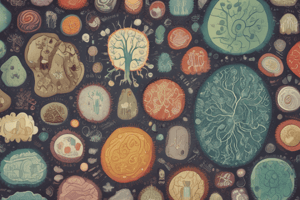Podcast
Questions and Answers
What delineates Archaea from other prokaryotic organisms?
What delineates Archaea from other prokaryotic organisms?
- Presence of peptidoglycan in their cell wall
- Ability to photosynthesize
- Lack of peptidoglycan in their cell wall (correct)
- Absence of organelles
In the five-kingdom system, which of the following kingdoms encompasses unicellular eukaryotes?
In the five-kingdom system, which of the following kingdoms encompasses unicellular eukaryotes?
- Monera
- Animalia
- Plantae
- Protista (correct)
Who was responsible for the term 'cell' and what was the significance of his work?
Who was responsible for the term 'cell' and what was the significance of his work?
- Anton van Leeuwenhoek; he discovered animalcules in water
- Francesco Redi; he disproved spontaneous generation
- Louis Pasteur; he developed germ theory
- Robert Hooke; he studied the microscopic structure of cork (correct)
What hypothesis posits that living organisms arise only from preexisting life?
What hypothesis posits that living organisms arise only from preexisting life?
Francesco Redi's experiments were pivotal in challenging which scientific belief?
Francesco Redi's experiments were pivotal in challenging which scientific belief?
What impact did Joseph Lister's antiseptic methods have on medical practice?
What impact did Joseph Lister's antiseptic methods have on medical practice?
What was Agostino Bassi's contribution to the germ theory of disease?
What was Agostino Bassi's contribution to the germ theory of disease?
What significant discovery did Ignaz Semmelweis make in the 1840s?
What significant discovery did Ignaz Semmelweis make in the 1840s?
What is the primary objective of Koch's postulates?
What is the primary objective of Koch's postulates?
Which of the following statements about Lister, Bassi, Semmelweis, and Koch is accurate?
Which of the following statements about Lister, Bassi, Semmelweis, and Koch is accurate?
Flashcards are hidden until you start studying
Study Notes
Classification of Microorganisms
- Archaea consist of prokaryotic cells without peptidoglycan, often inhabiting extreme environments.
- Eukarya includes eukaryotic cells and encompasses protists, fungi, plants, and animals.
- Taxonomic hierarchy organizes life into eight categories: Domain, Kingdom, Phylum, Class, Order, Family, Genus, and Species.
- The Five-Kingdom system classifies organisms into Monera (prokaryotes), Protista (unicellular eukaryotes), Fungi, Plantae, and Animalia.
A Brief History of Microbiology
- Robert Hooke (1665) published "Micrographia," coining the term "cell" and laying the foundation for cell theory.
- Anton van Leeuwenhoek observed live microorganisms, termed "animalcules," advancing microbiological discovery through his detailed sketches.
- The debate over spontaneous generation contrasted with biogenesis; the former posited life could emerge from nonliving matter, while the latter suggested life originates from preexisting life.
- Francesco Redi's 1668 experiments demonstrated that maggots originated from flies, supporting biogenesis and challenging spontaneous generation.
The First Golden Age of Microbiology
- Joseph Lister (1827-1912) pioneered antiseptic surgery, reducing infections through carbolic acid disinfection.
- Agostino Bassi (1835) identified a fungus as the cause of silkworm disease, providing early evidence for the germ theory of disease.
- Ignaz Semmelweis's discovery in the 1840s about the importance of handwashing in maternity wards laid the groundwork for hygiene practices.
- Robert Koch developed Koch's postulates to link specific microbes to diseases, identifying agents of anthrax, tuberculosis, and cholera.
Koch's Postulates
- The microorganism must be present in diseased organisms but absent in healthy ones.
- It must be isolated and grown in pure culture.
- When introduced into a healthy host, it should cause disease.
- The microorganism must be re-isolated from the experimentally infected host.
Vaccination and Chemotherapy
- Edward Jenner created the first vaccine in 1796 using cowpox material to immunize against smallpox, founding immunology.
- Paul Ehrlich developed chemotherapy concepts, notably Salvarsan for treating syphilis, heralding the era of antimicrobial treatment.
The Second Golden Age of Microbiology
- Alexander Fleming discovered penicillin in 1928 from Penicillium notatum, revolutionizing bacterial infection treatment and leading to antibiotic development.
Microbes and Human Welfare
- Microbes play crucial roles in recycling vital elements like carbon, nitrogen, sulfur, and phosphorus through natural cycles.
- The carbon cycle involves decomposition by microbes, which release CO₂, while photosynthetic microorganisms fix CO₂ for the food web.
- Nitrogen-fixing bacteria convert atmospheric nitrogen to forms usable by plants, essential for agriculture.
- Sulfur-oxidizing bacteria transform hydrogen sulfide into usable sulfur compounds, while sulfate-reducing bacteria return it to H₂S.
Sewage Treatment and Bioremediation
- Sewage treatment facilities use microbes to recycle water, removing pollutants through biological processes and converting organic matter into non-toxic by-products.
- Bioremediation employs microbes to clean up pollutants from toxins, oil spills, and chemical spills, using either indigenous or genetically modified species.
Insect Pest Control by Microorganisms
- Fungal pathogens like Beauveria bassiana and Metarhizium anisopliae target insect pests, aiding in integrated pest management.
- Beneficial nematodes such as Steinernema and Heterorhabditis utilize symbiotic bacteria to infect and kill soil-dwelling pests.
Studying That Suits You
Use AI to generate personalized quizzes and flashcards to suit your learning preferences.




